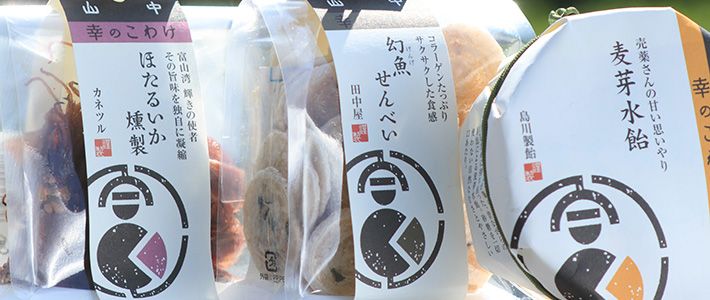
The Road to Hit Products by Kitamura Mori
New Twists on Famous Local Specialties
Economy Lifestyle- English
- 日本語
- 简体字
- 繁體字
- Français
- Español
- العربية
- Русский
Winds of Change for Omiyage Industry
Every local region across Japan has its own specialties—or omiyage—that are sold to tourists and other visitors. You can see omiyage on the shelves of stores next to train stations or inside regional airports. Indeed, a whole culture has grown up around the giving and receiving of these gifts.
The market for omiyage in Japan is enormous, with annual sales on the order of ¥2.5 trillion according to the Institute of Tourism and Tourist Products Research. In a market of this size, new goods appear all the time. Yet new product concepts are in fact rare. When an item hits it big, imitations soon follow. This was the case for the recent boom in bite-sized curry-flavored rice crackers; after sales of this Hokkaidō omiyage shot up, imitation goods appeared in the Kantō and Kansai regions.
Despite its huge size, the omiyage market faces an uncertain future. Sales of local specialties have leveled off over the past few years, according to the same institute. With household budgets tighter than ever, consumers are not interested in spending their money on the same old products, even if they are dressed up in new garb.
The winds of change may be on the way, however. One particular omiyage, which at first glance seems a repackaging of old ideas, is now grabbing a lot of attention. It may be a harbinger of fundamental change in the industry.
Toyama Prefecture Leads the Way
The omiyage in question, sold under the name Etchū Toyama Sachi no Kowake, is a lineup of 20 different small items from Toyama Prefecture, each individually wrapped in attractive packaging. The omiyage are sold mainly in shops in JR train stations or in Toyama Airport. The items in the lineup, which sell for around ¥500 each, include boiled fish paste shaped like a sea bream, pickled yellowtail and daikon, sun-dried Japanese glass shrimp, and delicate confectionaries made out of refined Japanese sugar. Even though Toyama is not a popular tourist destination, and no special efforts were made to publicize the omiyage, sales for the one-year period starting February 2011, when the series was released, reached ¥30 million; and a new record for monthly sales was set in May 2012.
One thing people like about the Toyama omiyage is that diverse lineup of items lets them personalize their choice of gifts for groups of coworkers or friends. And they can also bring home a few items for themselves because they are reasonably priced.
Several things are noteworthy about the Sachi no Kowake lineup. First, the items are all tried-and-true Toyama specialties produced and marketed by local manufacturers. Locals can vouch for the quality and taste of the times. This time-tested approach places the lineup a rank above the sort of flashy new omiyage that are developed quickly and rushed to market. Another feature is the affordable prices and small size of the items, and that each comes in its own packaging featuring a common design.
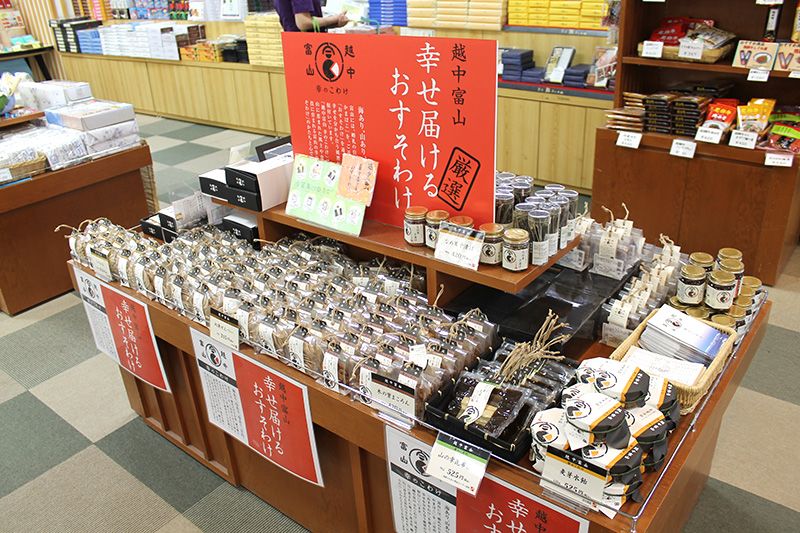 Sachi no Kowake goods on display at a shop inside Toyama Airport. Shoppers can select the items they want and have them wrapped in a gift box.
Sachi no Kowake goods on display at a shop inside Toyama Airport. Shoppers can select the items they want and have them wrapped in a gift box.
Trout Sushi Loses Out
A screening committee was set up to decide which items to include in the Sachi no Kowake lineup. The selection process involved reviewing each candidate item and conducting repeated taste tests. This was by no means a mere rubber-stamping process, as is clear from the unexpected fact that trout sushi, a famous Toyama specialty, did not make the cut.
Initially, a number of companies involved in producing trout sushi for the market were approached with regard to the Sachi no Kowake project, and a tie-up was made with one. At the taste-testing phase, the trout sushi was delicious, but once it was mass-produced and put on the market the screening committee members realized that the flavor fell short of the standards set. In response, all of the trout sushi items were pulled from the shelves. The producer was asked to go back to the drawing board and try again, but the end result was still not satisfactory. Ultimately, the business tie-up was dissolved and trout sushi was excluded from the lineup. Pulling a product from the shelves at that point must have been a very difficult decision.
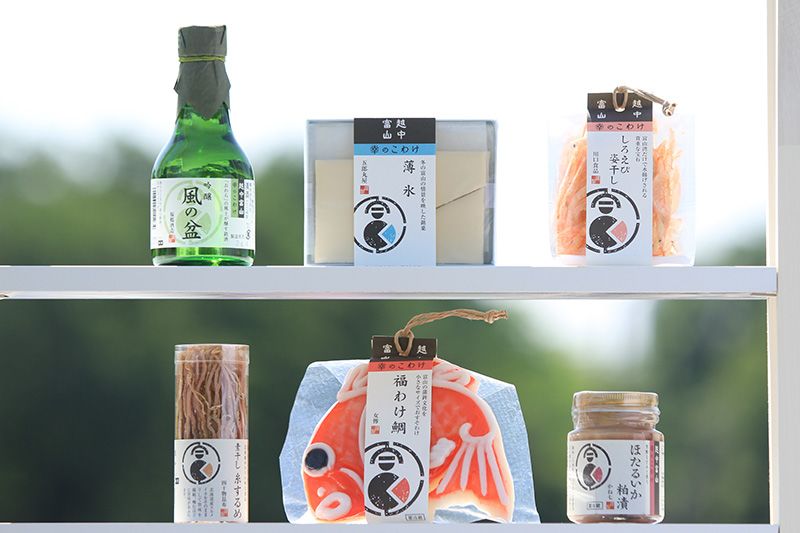 Each of the 20 items in the Sachi no Kowake lineup are long-standing favorites in Toyama. The only changes made were to the size and design of the packaging.
Each of the 20 items in the Sachi no Kowake lineup are long-standing favorites in Toyama. The only changes made were to the size and design of the packaging.
The Sachi no Kowake project is the brainchild of Toyama Design Center, an organization affiliated with the prefectural government. This extremely ambitious undertaking involves not just safeguarding a local industry but also screening manufacturers and pulling products and dissolving business arrangements.
Staying the Course
I spoke with Obata Yutaka and Kubo Hideaki, the two people involved in the project, to find out more. From our discussion, I got a clearer idea of the criteria that guided the screening process. They told me the products finally selected were only those that they personally would think of giving as gifts. Of course, since the project was run by a government-affiliated agency, following this approach was easier said than done; the center reportedly came under some pressure regarding the items to include.
Another guiding principle for the project leaders was the desire to reform administrative practices. Prefectural officials have already begun calling for the development and marketing of new local specialties in response to the opening of the Hokuriku Shinkansen (connecting Nagano and Kanazawa via Toyama) scheduled for the spring of 2015. There is a tendency among government agencies, unlike private-sector firms, to not carry through on a project after the initial effort. This gives participating companies from the local area the impression of being used, since projects have little chance of getting off the ground. Bucking that trend, Obata and Kubo wanted to zero in on outstanding products already on the market and see the project through to its conclusion. Given the current climate, the goals they set for themselves were ambitious.
The success of Sachi no Kowake led other sections in the prefectural government to consider launching similar projects, as well as calls for unrestricted use of the omiyage lineup’s logo. In my opinion, though, doing those things will not lead to innovation for the omiyage sector, nor will it benefit local industries. There are some good products on the market now, but you have got to separate the wheat from the chaff. This is just one of the many lessons that can be drawn from the Sachi no Kowake story.
Hope for a Struggling Local Industry
Another example of an innovative local specialty is the product Ikiteiru Nori, developed by Spec Lab, a food hygiene consulting company in Tokushima Prefecture.
Ikiteiru Nori, which sells for ¥1,050 per pack, offers customers the taste of freshly harvested seaweed. At present, the product is only available through mail order and is shipped frozen. Strictly speaking, it is not an omiyage that people buy locally, but I’m convinced Ikiteiru Nori will one day become a noted Tokushima product once counters are set up at train stations and the airports for travelers to place orders for delivery.
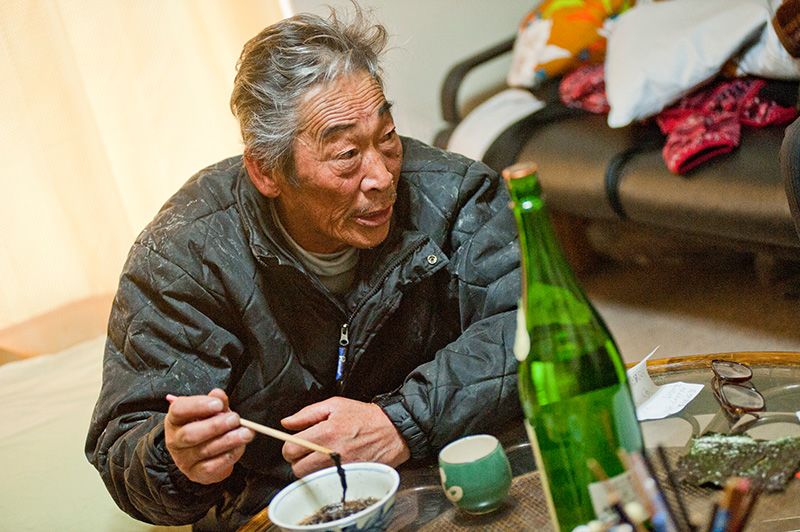 Until now, only fishermen in Tokushima could enjoy fresh seaweed. Pictured here is Kagawa Nobuaki, a local fisherman who provided behind-the-scenes support for the development of Ikiteiru Nori, allowing Spec employees to use his fishing hut for testing the product.
Until now, only fishermen in Tokushima could enjoy fresh seaweed. Pictured here is Kagawa Nobuaki, a local fisherman who provided behind-the-scenes support for the development of Ikiteiru Nori, allowing Spec employees to use his fishing hut for testing the product.
Seaweed harvesting is a thriving industry in Tokushima, but the sharp drop in prices in recent years, coupled with higher fishing operation costs, has made for a tough business climate.
Hoping to help out the hard-hit local fishing industry, the president of Spec, Tanaka Tatsuya, embarked three years ago on a project to develop a new seaweed product. Prior to the project, the company had focused on consulting and had no experience in developing or marketing products. But Tanaka’s desire to help out locals involved in fishing made him determined to succeed.
Undertaking a Challenge
In 2011, near the end of winter, I visited Tokushima and tasted freshly harvested seaweed at the home of a seaweed harvester. The seaweed was placed in a large bowl, topped with freshly squeezed bitter orange, sugar, and soy sauce, and then briefly mixed. The taste was unlike any seaweed I had ever tried. Stock phrases, like “smell of the ocean,” don’t do it justice: It was the essence of the ocean itself.
When Tanaka told seaweed fishers he wanted to market the seaweed, they laughed at him. Seaweed begins to spoil hours after it is harvested, which is why fresh seaweed is immediately sent out to companies and processed into sheets.
Prominent companies and university research labs had been trying for decades to figure out how to preserve freshly harvested seaweed, but no one had succeeded. How was a small company, with just over 20 employees and no experience in food processing, able to hit on the solution?
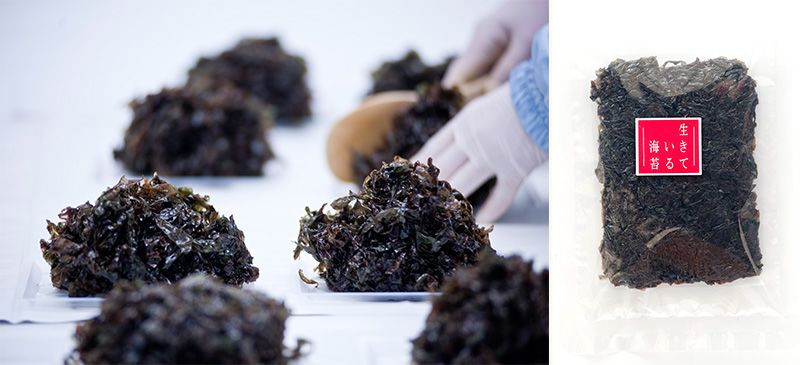 Hand-packed Ikiteiru Nori, which sells for ¥1,050 a pack, is shipped frozen to customers.
Hand-packed Ikiteiru Nori, which sells for ¥1,050 a pack, is shipped frozen to customers.
Bigger Isn’t Always Better
Tanaka tells me that the key to preserving fresh seaweed was simply to “test every imaginable possibility.” Basically, there were three variables to consider: the temperature at which to freeze seaweed, the speed of the freezing process, and the amount of water contained in the seaweed. By testing every combination of those variables, the project members were able to arrive at the ideal preservation method.
This willingness to conduct what must have seemed like an insane number of tests is what set Spec apart from the big manufacturers. It is not unusual in Japan these days for smaller businesses to develop products that are the envy of large firms. I believe that the level of their commitment is the secret to their success. These small businesses sometimes choose to push on with a project, even when the odds of success seem low.
A thousand yen may seem like a lot of money to pay for seaweed. And, to be honest, this was my initial reaction. But Ikiteiru Nori is special; it’s the only freshly harvested seaweed available on the market. Just over a year after its appearance, the product has already gained a solid reputation as a Tokushima specialty, as orders pour in from not only individuals but also from famous restaurants in Kyoto and Tokyo.
The one thing that both Sachi no Kowake and Ikiteiru Nori have in common is the idea of seeking one’s fortune close to home. Instead of looking to big-name consultants or famous chefs to create a hit omiyage, local areas are beginning to realize that they can revitalize themselves by giving a new twist to their unique specialty items.
(Originally written in Japanese. Photographs by Kawai Satoshi [Sachi no Kowake series], Kitamura Mori [Sachi no Kowake store], and Otaka Kazuyasu [Ikiteiru Nori]. )
seaweed Hokkaidō Mori product Kitamura Toyama Tokushima local popular seafood specialties speciality omiyage gift souvenir Toyama Design Center Hokuriku Shinkansen Spec airport confectionaries tourist destination shrimp trout sushi fishermen